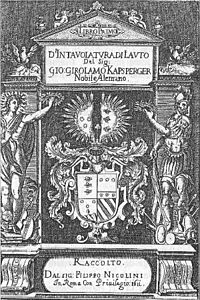|
Giovanni Girolamo KapspergerGiovanni Girolamo Kapsperger (also: Johann(es) Hieronymus Kapsberger or Giovanni Geronimo Kapsperger; c. 1580 – Rome 17 January 1651) was an Austrian-Italian virtuoso performer and composer of the early Baroque period. A prolific and highly original composer, Kapsberger is chiefly remembered today for his lute and theorbo (chitarrone) music, which was seminal in the development of these as solo instruments.  His nickname was "the German of the theorbo", deriving from his fame as a virtuoso of the theorbo and of the other instruments belonging to the lute family. LifeNothing is known about Kapsberger's date and place of birth. His father Colonel Wilhelm (Guglielmo) von Kapsperger was a military official of the Imperial House of Austria, and may have settled in Venice, the city which may have been Kapsberger's birthplace. After 1605 Kapsberger moved to Rome, where he quickly attained a reputation as a brilliant virtuoso. He cultivated connections with various powerful individuals and organizations and organized "academies" in his house, which were counted among the "wonders of Rome". Around 1609 Kapsberger married Gerolima di Rossi, with whom he had at least three children. He started publishing his music at around the same time, with more than a dozen collections of music appearing during the next ten years. These included the celebrated Libro I d'intavolatura di lauto (1611), Kapsberger's only surviving collection of music for lute.[1] In 1624 Kapsberger entered the service of Cardinal Francesco Barberini, where he worked with numerous important composers, such as Girolamo Frescobaldi and Stefano Landi, and poets which included Giulio Rospigliosi, the future Pope Clement IX. Kapsberger worked in Barberini's household until 1646. He died in 1651.[1] Works Kapsberger is best remembered as a composer for lute and theorbo. At least six collections were published during his lifetime, two of which are currently lost. Kapsberger's writing is characterized, especially in toccatas, by spontaneous changes, sharp contrasts, unusual rhythmic groupings and, sometimes, passages that do not conform to the rules of counterpoint that were in use at the time.[1] The vast majority of contemporary critics praised Kapsberger's compositional skill and innovations. Among them was Athanasius Kircher, who described Kapsberger as a "superb genius" and attested that he has "successfully penetrated the secrets of music."[2] One notable exception was the critic Giovanni Battista Doni, who was initially supportive of the composer, but then turned against him for unclear reasons and criticised his music in print.[3] Some contemporaries, such as Stefano Landi, mentioned that Kapsberger was not as meticulous a composer as he was as a performer.[3] The features listed above led some modern scholars to share this view and they tend to believe that Kapsberger was a composer of inferior ability. Prominent among these critics is lutenist Rolf Lislevand: in his words, "Kapsberger was as bad a composer as he was a fine instrumentalist [...] The ideas are often badly developed, and are freely associated with one another; no real musical discourse is built up [...] the rhythm—even after serious efforts at fathoming it—wavers between inspired cleverness and total confusion."[4] Regardless of how one regards his compositional prowess, Kapsberger was one of the principal composers of lute and theorbo music during the early Baroque era (together with Alessandro Piccinini) and greatly contributed towards advancing European plucked string instruments of the time.[1] Also, Kapsberger's toccatas may have influenced those of Girolamo Frescobaldi,[5] much like French lute music would, some years later, influence Johann Jakob Froberger's suites. Kapsberger's other music includes two collections of instrumental ensemble dances, rare for the period, and a wealth of vocal music, which was widely performed during his lifetime, but which is now critically less acclaimed. Kapsberger also wrote stage music, almost all currently lost. The only surviving work of this kind is Apotheosis sive Consecratio SS Ignatii et Francisci Xaverii (1622).[1] List of worksThis list only includes works published during the composer's lifetime. The few pieces that survive in manuscripts, as well as pieces of questionable attribution, are not included. Lute and theorbo
Other instrumental
Sacred vocal
Secular vocalVillanellas
Arie passeggiate
Other works
Stage
Lost
Also, a compositional treatise by Kapsberger, Il Kapsperger della musica, was announced in 1640 in the preface to Libro quarto d'intavolatura di chitarrone, but is now lost. Notes
References
External linksWikimedia Commons has media related to Johannes Hieronymus Kapsberger.
|